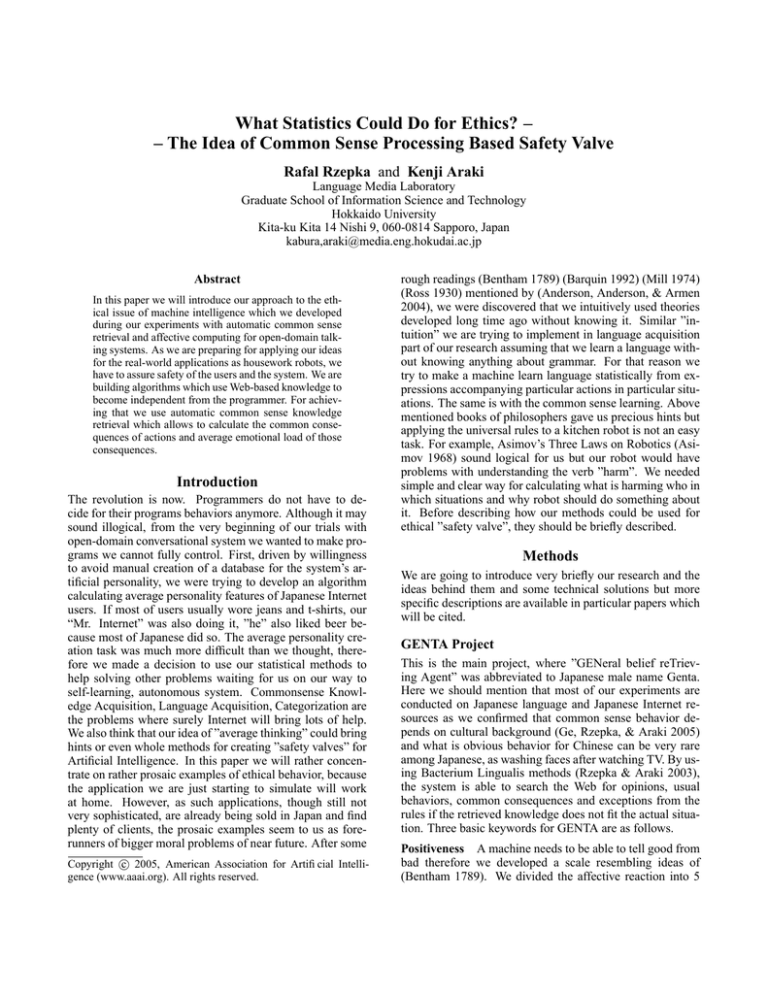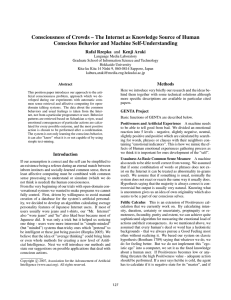
What Statistics Could Do for Ethics? –
– The Idea of Common Sense Processing Based Safety Valve
Rafal Rzepka and Kenji Araki
Language Media Laboratory
Graduate School of Information Science and Technology
Hokkaido University
Kita-ku Kita 14 Nishi 9, 060-0814 Sapporo, Japan
kabura,araki@media.eng.hokudai.ac.jp
Abstract
In this paper we will introduce our approach to the ethical issue of machine intelligence which we developed
during our experiments with automatic common sense
retrieval and affective computing for open-domain talking systems. As we are preparing for applying our ideas
for the real-world applications as housework robots, we
have to assure safety of the users and the system. We are
building algorithms which use Web-based knowledge to
become independent from the programmer. For achieving that we use automatic common sense knowledge
retrieval which allows to calculate the common consequences of actions and average emotional load of those
consequences.
Introduction
The revolution is now. Programmers do not have to decide for their programs behaviors anymore. Although it may
sound illogical, from the very beginning of our trials with
open-domain conversational system we wanted to make programs we cannot fully control. First, driven by willingness
to avoid manual creation of a database for the system’s artificial personality, we were trying to develop an algorithm
calculating average personality features of Japanese Internet
users. If most of users usually wore jeans and t-shirts, our
“Mr. Internet” was also doing it, ”he” also liked beer because most of Japanese did so. The average personality creation task was much more difficult than we thought, therefore we made a decision to use our statistical methods to
help solving other problems waiting for us on our way to
self-learning, autonomous system. Commonsense Knowledge Acquisition, Language Acquisition, Categorization are
the problems where surely Internet will bring lots of help.
We also think that our idea of ”average thinking” could bring
hints or even whole methods for creating ”safety valves” for
Artificial Intelligence. In this paper we will rather concentrate on rather prosaic examples of ethical behavior, because
the application we are just starting to simulate will work
at home. However, as such applications, though still not
very sophisticated, are already being sold in Japan and find
plenty of clients, the prosaic examples seem to us as forerunners of bigger moral problems of near future. After some
c 2005, American Association for Artificial IntelliCopyright °
gence (www.aaai.org). All rights reserved.
rough readings (Bentham 1789) (Barquin 1992) (Mill 1974)
(Ross 1930) mentioned by (Anderson, Anderson, & Armen
2004), we were discovered that we intuitively used theories
developed long time ago without knowing it. Similar ”intuition” we are trying to implement in language acquisition
part of our research assuming that we learn a language without knowing anything about grammar. For that reason we
try to make a machine learn language statistically from expressions accompanying particular actions in particular situations. The same is with the common sense learning. Above
mentioned books of philosophers gave us precious hints but
applying the universal rules to a kitchen robot is not an easy
task. For example, Asimov’s Three Laws on Robotics (Asimov 1968) sound logical for us but our robot would have
problems with understanding the verb ”harm”. We needed
simple and clear way for calculating what is harming who in
which situations and why robot should do something about
it. Before describing how our methods could be used for
ethical ”safety valve”, they should be briefly described.
Methods
We are going to introduce very briefly our research and the
ideas behind them and some technical solutions but more
specific descriptions are available in particular papers which
will be cited.
GENTA Project
This is the main project, where ”GENeral belief reTrieving Agent” was abbreviated to Japanese male name Genta.
Here we should mention that most of our experiments are
conducted on Japanese language and Japanese Internet resources as we confirmed that common sense behavior depends on cultural background (Ge, Rzepka, & Araki 2005)
and what is obvious behavior for Chinese can be very rare
among Japanese, as washing faces after watching TV. By using Bacterium Lingualis methods (Rzepka & Araki 2003),
the system is able to search the Web for opinions, usual
behaviors, common consequences and exceptions from the
rules if the retrieved knowledge does not fit the actual situation. Three basic keywords for GENTA are as follows.
Positiveness A machine needs to be able to tell good from
bad therefore we developed a scale resembling ideas of
(Bentham 1789). We divided the affective reaction into 5
levels - negative, slightly negative, neutral, slightly positive and positive which are calculated by counting words,
phrases or clauses with their neighbors containing ”emotional indicators” (Rzepka, Araki, & Tochinai 2002). The
simplest example is the basic opinion check which is calculated by following formulae:
P ositiveness =
C α1 + C α2 ∗ γ
Cβ1 + C β2 ∗ γ
α1 = disliked, α2 = hated
β1 = liked, β2 = loved, γ = 1.3
where
γ
is to strengthen the love and hate values. For example we
can easily see that beer is something most Japanese like, especially when it is cold but the negative opinions dominate
when the query is ”warm beer”. This way the agent can react naturally when the state of given object may cause low
Positiveness value.
Usualness A machine also needs to be able to tell correct
from wrong. We assumed that if some combination of words
or phrases does not exists it can be treated as abnormality
which is a popular n-gram frequency checkup but concentrating on Japanese particles which we find very useful for
retrieving common sense. We assume that if something is
usual, normally the system does not react or reacts the same
way it usually does. Hypothesis saying that the majority is
always correct is not maybe perfect and may cause discussion, we keep it till it works. We think that situations which
happen also among people where most of us are wrong (as
in the example where only few knows the real height of Mt.
Everest re-measured with the latest satellite techniques) but
we believe this kind of erroneous common belief is harmless
- exactly as it does not affect our everyday lives.
Good Feeling Pursuit Hypothesis Above all rules which
are supposed to be retrieved automatically we set an overall assumption which brings our emotions to Pavlov’s reaction level (Rzepka, Araki, & Tochinai 2004). We based our
system on a hypothesis, again resembling thoughts of (Bentham 1789) that whatever we do, we do for feeling good. If
Positiveness becomes low or anything threaten the high Positiveness value even if actual state is not negative - adequate
actions should be performed. If the users says he is cold,
the agent has to calculate if it is negative state for its master,
if so, check what kind of actions are usually performed then
after confronting the possibilities with own functions and environment - the action should be proposed. This is the case
when the Master User is around - when the robot is alone or
with Sub-users (for example little kids) the decisions must
be made by a machine and it is where the common sense has
to become a safety valve.
Bacterium Lingualis
For retrieving more complicated language structures and dependencies we use our multi-functional web crawler called
Bacterium Lingualis. Its task is to collect the knowledge
when is needed form the brain cells which in our theory
are the Japanese web pages. The main idea about treating
WWW as a brain is that the more times an experience is imprinted in our minds, the more commonsensical it becomes
- other corpora as newspapers will not give us enough expressions about everyday happenings or physical dependencies between objects and human’s natural reactions. One
of the novelties in this method is Backward Categorization
(Rzepka, Itoh, & Araki 2004b) which treats category label naming as the last part of categorization - this idea we
took from observing children who learning inductively are
able to call groups of objects long after knowing its members (first ”dog”, ”elephant”, ”cat”, then later ”animals” and
later ”mammals”). Temporal labeling is made with verbs
and particles, for example human beings will be categorized
as ”talk-to” or ”play-with” rather than ”homo sapiens”. We
believe in the overall effectiveness of imitating children concepts in language and common sense acquisition and we also
want them to be crucial for the future ”morality acquisition”,
too. Bacterium’s three most important functions are as follows.
Exception Processing As the context is the clue for many
failures of universal rules we do our best to find as many
eventual exceptions of behaviors, opinions and rules, as possible. Even very simple Positiveness measures may be not
true depending who is talking about the measured matter.
For most people sweets are pleasure but for a mother of a
little baby it can be nightmare ruining the offspring’s teeth.
Schankian Scripts Retrieval We use works of (Schank
& Abelson 1997) to retrieve and calculate common behavior patterns (Rzepka, Itoh, & Araki 2004a) which combined
with Positiveness calculation give the system information
about what consequences will a given action bring. For example stealing, raping and killing are measured by the Positiveness but neutral escaping becomes negative while inside
of ”robbery script”.
Causal Rules Retrieval This works on the same basis as
Scripts Retrieval but uses several Japanese ”if” forms which
have abilities to categorize causal dependencies. In this case
Usualness of single happenings becomes more important - if
a Script cannot be created, it can be made from single causalities generalized semantically with Backward Categorizing.
Near Future Implementation
This year we want to combine our methods developed so far
and test them by simulating a close-environment robot. It is
supposed to live with one person in a virtual little flat with
one room, kitchen, etc. It will be given only basic knowledge of furniture and full list of its own technical possibilities (simple actions as grasping, carrying, pouring, etc. and
their simple combinations as ”bringing” is grasping + carrying + passing). In the first stage the safety calculations will
be checked when user is not at home. Except simple tests as
fire simulation we plan to create intruders which would behave differently. The goal will be to discover the danger and
react properly. At this point we expect an enormous amount
of new problems and probably not less failures due to new
circumstances. Talking agent did not need any attachment
to things and we simply do not know yet if such ”emotion”
is retrievable. If yes, will it then react as most people - get
scared and do nothing? Can the machine be called useful
then, just because it did not assault the intruder? If it illtread him will he be able to sue the robot’s owner or rather
programmer? Could he be sued if that was most of society
who decided the action? Such questions may appear but our
experiments done by now suggest that calling 911 would be
the action chosen in this case.
Kitchen Problems vs. World Problems
As we can see almost every day, lots of happenings around
us are unpredictable. But we do not want machines which
react unpredictable for such happenings. We claim that if
robots learn, as children, in closed environments first, if
their processing of ”smaller accidents” is well evaluated (although learning, feedback and evaluation processes were not
mentioned here, they may become very important depending
on the machine’s purpose), we could count on their ability
for creating analogies. But another question is - do we want
machines to decide for ourselves where we are not at home
just because they are able to create analogies? Our methods eliminate bigger scale problem analysis in most cases
naturally. For example there is approximately 40.9 times
more information on the Web about what to do when one
cuts his/her finger than what to do when one rules the world.
This could also become a safety valve as program might use
thresholds to ignore too peculiar possibilities.
Conclusions
The main message we want to pass to the machine ethics
community is that as we learn language without learning
grammar, most of people behave ethically without learning
ethics. We would like our robot learn to chose actions as
most people of given culture do without deeper analysis of
generalizations made by philosophers. Most of us do not
think seriously of ruling the world, stealing to have pleasures
and killing for calming own anger. The answer why we do
not think about it is difficult and this is also a reason why we
usually do not try to answer such questions. If we presume
that our lives are a constant struggle between emotions and
common sense, a struggle which keeps our ”life balance”,
what if everyone was independent from the society, what if
there is nothing as ”average”? Do we need machines which
obey some general rules decided by a few persons? Are
”general rules” the ”universal rules”? Or maybe – even with
all the controversy that it would bring - wouldn’t it be safer
to have machines imitating millions not few? All these questions we would like to leave unanswered as it is too early for
us to answer, although we hope to answer at least some of
them until the AAAI Fall Symposium. Because we have
never had an opportunity to confront our ideas with machine
ethics researchers, this paper is also meant to trigger the discussion about the pros and cons of ”democracy-depended
algorithms”.
References
Anderson, M.; Anderson, S. L.; and Armen, C. 2004. Towards machine ethics. In Proceedings of the AOTP’04 The AAAI-04 Workshop on Agent Organizations: Theory
and Practice.
Asimov, I. 1968. I, Robot. London: Grafton Books.
Barquin, R. 1992. In pursuit of a ’ten commandments’ for
computer ethics. http://www.brook.edu/its/cei/papers/.
Bentham, J. 1789. An Introduction to the Principles and
Morals of Legislation. London: T. Payne.
Ge, Y.; Rzepka, R.; and Araki, K. 2005. Automatic scripts
retrieval and its possibilities for soft science support applications. In Proceedings of Intelligent Information Systems 2005 - New Trends in Intelligent Information Processing and Web Mining, Computer Science. Gdansk, Poland:
Springer-Verlag.
Mill, J. S. 1974. Utilitarianism, in Utilitarianism and
Other Writings. New York: New American Library, 253
edition.
Ross, D. 1930. The Right and the Good. Oxford: Clarendon Press.
Rzepka, R., and Araki, K. 2003. Bacterium lingualis - the
web-based commonsensical knowledge discovery method.
In 6th International Conference on Discovery Science (DS
2003), volume 2843 of Lecture Notes in Artifical Intelligence, 453–460. Berlin, Heidelberg, New York: SpringerVerlag.
Rzepka, R.; Araki, K.; and Tochinai, K. 2002. Is it out
there? the perspectives of emotional information retrieval
from the internet resources. In Proceedings of the Artificial
Intelligence and Applications Conference, 22–27. Malaga:
IASTED.
Rzepka, R.; Araki, K.; and Tochinai, K. 2004. Ideas for
the web-based affective processing. In Proceedings of the
Seventh Multi-Conference on Systemics, Cybernetics and
Informatics, volume XIV of Computer Science, 376–381.
Orlando, Florida: IIIS.
Rzepka, R.; Itoh, T.; and Araki, K. 2004a. Rethinking
plans and scripts realization in the age of web-mining. In
IPSJ SIG Technical Report, 2004-NL-162, 11–18.
Rzepka, R.; Itoh, T.; and Araki, K. 2004b. Toward fully
automatic categorization for commonsense processing. In
Proceedings of the Language Sense on Computer 2004 Part of the Eight Pacific Rim International Conference on
Artificial Intelligence, 40–46.
Schank, R., and Abelson, R. 1997. Scripts, Plans, Goals
and Understanding: an Inquiry into Human Knowledge
Structures. Hillsdale, NJ: L. Erlbaum.









